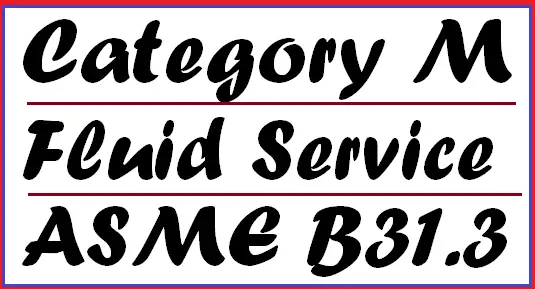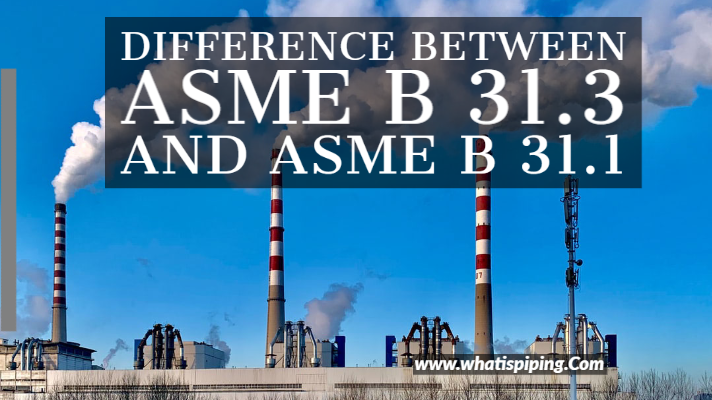While referring ASME B31.3 code we come across various types of fluid services. In day-to-day engineering design activities, we normally design and construct systems following the rules of Normal Fluid service. Category M fluid service is different from normal fluid service. As defined in clause 300.2 of ASME B31.3 Category M Fluid Service is a fluid service in which both of the following two conditions apply:
- the fluid is so highly toxic (poisonous or lethal) that a single exposure to a very small quantity of the fluid, caused by leakage, can produce serious irreversible harm to persons on breathing or bodily contact, even when prompt restorative measures are taken.
- after consideration of piping design, experience, service conditions, and location, the owner determines that the requirements for Normal Fluid Service do not sufficiently provide the leak tightness required to protect personnel from exposure.
Chapter VIII of ASME B31.3 code provides rules for piping designated by the owner as being in Category-M Fluid Service which means It is the owner’s responsibility to select the fluid service category. Selections of Category D or Category M cannot be made without the owner’s permission.
Also note that it is Category M Fluid Service and not Category M fluids, as it is not simply the fluid, but also the conditions of installation that are considered in making the designation. The owner is guided in the classification of the piping system by the definition of Category M Fluid Service in Chapter I of ASME B31.3. Additionally, a guide to the application of these rules is provided in ASME B31.3, Appendix M, which contains a flow chart to assist the owner in classifying fluid services. This Appendix is considered by the Code to provide guidance, not Code requirements.

It is not possible to create a list of Category M fluids, because the conditions of the installation must be considered in making the classification. For a fluid service to be Category M, the potential for personnel exposure must be judged to be significant. If piping is double-contained, for example, it could be judged that even highly toxic fluids (such as methyl isocyanate, phosgene, or nerve gas) do not make the system Category M, because the potential for personnel exposure is not significant. For Category M fluid service, the rules for Normal Fluid Service are not applicable. Instead, additional rules that lead to more costly construction, with provisions designed to enhance piping system tightness, are provided in Chapter VIII.
If higher integrity piping is desired by the owner, even though the fluid service does not meet the definition of Category M, the owner can still specify the additional design, construction, examination, and testing requirements that are provided in Chapter VIII. Hydrofluoric acid is one example of a fluid for which many owners specify more stringent requirements than are provided in the Code for Normal Fluid Service, although it actually would be considered Normal Fluid Service.
Normally the following should be applicable for Category M fluid services.
- Use of any temperature other than the fluid temperature as the design temperature shall be substantiated by heat transfer calculations confirmed by tests or by experimental measurements.
- Design, layout, and operation of piping shall be conducted so as to minimize impact and shock loads.
- Suitable dynamic analysis, such as computer simulation, shall be made where necessary to avoid or minimize conditions that lead to detrimental vibration, pulsation, or resonance effects in the piping.
- Allowance for Pressure and Temperature Variations, Metallic Piping is not permitted.
- Valves having threaded bonnet joints (other than union joints) shall not be used.
- Special consideration shall be given to valve design to prevent stem leakage into the environment.
- Bonnet or cover plate closures and body joints shall be flanged and secured by at least four bolts with gasketing.
- Single-welded slip-on flanges, expanded-joint flanges, slip-on flanges used as lapped flanges, and threaded metallic flanges, except those employing lens rings or similar gaskets and those used in the lined pipe where the liner extends over the gasket face, shall not be used.
- Split backing rings shall not be used.
- Socket welded joints greater than DN 50 (NPS 2) are not permitted.
- Caulked joints shall not be used.
- Soldered, brazed, and braze welded joints shall not be used. adhesive joints and bell-type joints shall not be used.
- Relief set pressure shall be in accordance with ASME BPVC, Section VIII, Division 1.
- The maximum relieving pressure shall be in accordance with Section VIII, Division 1.
- Materials of unknown specification shall not be used.
- A piping system designed for Category M service fluid preferably shall not go under severe cyclic conditions
- No variations in design pressure and/or design temperatures shall be considered even in occasional cases
- Creased or Corrugate type of bends shall not be used
- Miter bends shall not make a change in direction at a single joint greater than 22.5 deg
- Special consideration shall be given to valve design to prevent stem leakage into the environment
Click here for a basis for determining ASME B31.3 Category M fluid services









Great work Sir
very helpful for beginners & useful in learning all concepts.
Hi Anup does Phosphoric Acid 54 percent strength catergorise as Category M or D fluid? If we need to design a pipeline of long run should it be designed to ASME B31.3 or 31.4 ? As per scope of 31.4 it doesn not cover hazardous fluid.